Forest Fires, Vulnerability, and Exposure: The Evaluation of What Was Salvaged in the 2023 Fire in Tenerife (Spain)
Abstract
1. Introduction
2. Materials and Methods
2.1. Fire Characterization and Management
2.2. Diagnosis of Vulnerability and Exposure of Buildings Surrounding the Urban–Forest Interface
2.2.1. Structural Vulnerability Index (SVI)
2.2.2. Accessibility Exposure Index (AEI)
2.2.3. Territorial Exposure Index (TEI)
2.2.4. Vegetation Exposure Index (VEI)
2.2.5. Fire-Affected Vegetation Index (FAVI)
2.3. Assessment of the Value of the Salvaged Assets
2.3.1. Delimitation of Fire Spreading Sectors
2.3.2. Estimation of the Economic Value of the Salvaged
3. Results
3.1. Building Vulnerability and Exposure Analysis
3.1.1. Structural Vulnerability Index (SVI) Results
3.1.2. Accessibility Exposure Index (AEI) Results
3.1.3. Territorial Exposure Index (TEI) Results
3.1.4. Vegetation Exposure Index (VEI) Results
3.1.5. Fire-Affected Vegetation Index (FAVI) Results
3.1.6. Wildfire Risk Building Vulnerability and Exposure Index (WR-BVEI)
3.2. Estimated Value of the Salvaged
4. Discussion
5. Conclusions
Author Contributions
Funding
Data Availability Statement
Acknowledgments
Conflicts of Interest
References
- Chuvieco, E.; Martín, M.P.; Martínez, J.; Salas, F.J. Geografía e Incendios Forestales. Ser. Geográfica 1998, 7, 11–17. Available online: http://hdl.handle.net/10261/6427 (accessed on 5 March 2025).
- Moreno, J.M. (Ed.) Forest Fires Under Climate, Social and Economic Changes in Europe, the Mediterranean and Other Fire-Affected Areas of the World. FUME Project 2014. Available online: https://horizon.documentation.ird.fr/exl-doc/pleins_textes/divers15-08/010065139.pdf (accessed on 5 March 2025).
- Abatzoglou, J.; Williams, A.; Barbero, R. Global Emergence of Anthropogenic Climate Change in Fire Weather Indices. Geophys. Res. Lett. 2019, 46, 326–336. [Google Scholar] [CrossRef]
- Dupuy, J.; Fargeon, H.; Martin-StPaul, N.; Pimont, F.; Ruffault, J.; Guijarro, M.; Hernando, C.; Madrigal, J.; Fernandes, P. Climate change impact on future wildfire danger and activity in southern Europe: A review. Ann. For. Sci. 2019, 77, 35. [Google Scholar] [CrossRef]
- Jones, M.; Abatzoglou, J.; Veraverbeke, S.; Andela, N.; Lasslop, G.; Forkel, M.; Smith, A.; Burton, C.; Betts, R.; Werf, G.; et al. Global and Regional Trends and Drivers of Fire Under Climate Change. Rev. Geophys. 2022, 60, e2020RG000726. [Google Scholar] [CrossRef]
- Radeloff, V.; Helmers, D.; Kramer, H.; Mockrin, M.; Alexandre, P.; Bar-Massada, A.; Butsic, V.; Hawbaker, T.; Martinuzzi, S.; Syphard, A.; et al. Rapid growth of the US wildland-urban interface raises wildfire risk. Proc. Natl. Acad. Sci. USA 2018, 115, 3314–3319. [Google Scholar] [CrossRef]
- Bento-Gonçalves, A.; Vieira, A. Wildfires in the wildland-urban interface: Key concepts and evaluation methodologies. Sci. Total Environ. 2019, 707, 135592. [Google Scholar] [CrossRef]
- Ascoli, D.; Moris, J.; Marchetti, M.; Sallustio, L. Land use change towards forests and wooded land correlates with large and frequent wildfires in Italy. Ann. Silvic. Res. 2021, 46, 177–188. [Google Scholar] [CrossRef]
- Salis, M.; Giudice, L.; Jahdi, R.; Alcasena-Urdiroz, F.; Scarpa, C.; Pellizzaro, G.; Bacciu, V.; Schirru, M.; Ventura, A.; Casula, M.; et al. Spatial Patterns and Intensity of Land Abandonment Drive Wildfire Hazard and Likelihood in Mediterranean Agropastoral Areas. Land 2022, 11, 1942. [Google Scholar] [CrossRef]
- Moreno, J.M. La nueva gestión del incendio forestal ante el cambio climático. Ambienta 2021, 34–35. Available online: https://dialnet.unirioja.es/servlet/articulo?codigo=8213446 (accessed on 5 March 2025).
- Castilla-Beltrán, Á.; De Nascimento, L.; Fernández-Palacios, J.; Whittaker, R.J.; Willis, K.J.; Edwards, M.; Nogué, S. Anthropogenic transitions from forested to human-dominated landscapes in southern macaronesia. Proc. Natl. Acad. Sci. USA 2021, 118, e2022215118. [Google Scholar] [CrossRef]
- Santos-Guerra, A. Clima mediterráneo de Canarias y vegetación. Bull. Soc. Bot. Fr. Actual. Bot. 1984, 131, 121–128. [Google Scholar] [CrossRef][Green Version]
- Sánchez-Benítez, A.; García-Herrera, R.; Vicente-Serrano, S.M. Revisiting precipitation variability, trends and drivers in the Canary Islands. Int. J. Climatol. 2017, 37, 3525–3752. [Google Scholar] [CrossRef]
- Dorta, P. Estado de la atmósfera en las olas de calor estivales en Canarias. Ería 1990, 205–212. Available online: https://reunido.uniovi.es/index.php/RCG/article/view/1062 (accessed on 5 March 2025).
- Dorta, P. Aproximación a la influencia de las advecciones de aire sahariano en la propagación de los incendios forestales en la provincia de Santa Cruz de Tenerife. In Actas del XVII Congreso de Geógrafos Españoles; Rodríguez-Gutiérrez, F., Menéndez Fernández, R., Montes Vigon, S., Poncelas Nietoz, M., Eds.; Universidad de Oviedo: Oviedo, Spain, 2001; pp. 158–162. Available online: https://dialnet.unirioja.es/servlet/articulo?codigo=7564844 (accessed on 5 March 2025).
- Quirantes, F.; Núñez-Pestano, J.R.; García-Mesa, D.A. Historia de los Montes de Tenerife; Servicio de Publicaciones de la Universidad de La Laguna: San Cristóbal de La Laguna, Spain, 2011. [Google Scholar]
- Dorta, P. Las inversiones térmicas en Canarias. Investig. Geogr. 1996, 109–124. Available online: https://www.redalyc.org/pdf/176/17654244007.pdf (accessed on 5 March 2025).
- Huesca-Martínez, M.; González-Alonso, F.; Cuevas, J.M.; Merino-de-Miguel, S. Estimación de la superficie quemada en los incendios forestales de Canarias en 2007 utilizando sinérgicamente imágenes MODIS y anomalías térmicas. Investig. Agrar. Sist. Recur. Forestales 2008, 17, 308–316. Available online: https://oa.upm.es/2263/ (accessed on 5 March 2025).
- ISTAC. Estadística de Incendios Forestales en Canarias/Series anuales o mensuales. Islas de Canarias. 1968–2022. 2025. Available online: https://www3.gobiernodecanarias.org/istac/statistical-visualizer/visualizer/data.html?resourceType=dataset&agencyId=ISTAC&resourceId=E04002B_000001&version=~latest#visualization/table (accessed on 5 March 2025).
- Tomé, J.L.; Fernández-Landa, A.; Ranz, P.P. Elaboración de cartografía forestal en canarias a partir de datos LIDAR. In Investigación, Gestión y Técnica Forestal en la Región de la Macaronesia; Santamarta, J.C., Ed.; Colegio de Ingenieros de Montes: Madrid, Spain, 2014; pp. 185–200. Available online: https://dialnet.unirioja.es/descarga/articulo/4996617.pdf (accessed on 5 March 2025).
- Carrillo, J.; Pérez, J.C.; Expósito, F.J.; Díaz, J.P.; González, A. Projections of wildfire weather danger in the Canary Islands. Nature 2022, 12, 8093. [Google Scholar] [CrossRef]
- González-Morales, A.; Ramón-Ojeda, A. Hacia una nueva propuesta de interpretación del paisaje agrario canario. Estud. Geogr. 2017, 78, 579–604. [Google Scholar] [CrossRef]
- Del Arco-Aguilar, M.J.; Rodríguez-Delgado, O. Vegetation of the Canary Islands. In Vegetation of the Canary Islands. Plant and Vegetation; Del Arco-Aguilar, M.J., Rodríguez-Delgado, O., Eds.; Springer: Cham, Switzerland, 2018; Volume 16, pp. 83–319. [Google Scholar] [CrossRef]
- Ministerio de Agricultura, Alimentación y Medio Ambiente. Criterios e Indicadores de Gestión Forestal Sostenible en los Bosques Españoles; Ministerio de Agricultura, Alimentación y Medioambiente: Madrid, Spain, 2012; Available online: https://www.miteco.gob.es/content/dam/miteco/es/biodiversidad/publicaciones/informe_castellano_criterios_indicarores_gestion_forestal_sostenible_bosques_2012_tcm30-101191.pdf (accessed on 5 March 2025).
- Diario de Avisos. ¿Qué Significa que el Incendio de Tenerife Sea de Sexta Generación? 20 August 2023. Available online: https://diariodeavisos.elespanol.com/2023/08/incendio-tenerife-sexta-generacion/ (accessed on 5 March 2025).
- Ministerio para la Transición Ecológica y el Reto Demográfico. Los Incendios Forestales en España. 1 Enero–31 de Diciembre 2023. Avance Informativo. 2024. Available online: https://www.miteco.gob.es/content/dam/miteco/es/biodiversidad/temas/incendios-forestales/Avance_1_enero_31_diciembre_2023.pdf (accessed on 5 March 2025).
- AEMET. Candelaria-Deposito Cuevecitas en Agosto de 2023. Observación Meteorológica Horaria. 2023. Available online: https://x-y.es/aemet/est-C438N-candelaria-deposito-cuevecitas?mes=2023-08 (accessed on 5 March 2025).
- AEMET. Olas de Calor en España Desde 1975. Área de Climatología y Aplicaciones Operativas. 2023. Available online: https://www.aemet.es/documentos/es/conocermas/recursos_en_linea/publicaciones_y_estudios/estudios/Olas_calor/olas_calor_actualizacionoct2023.pdf (accessed on 5 March 2025).
- Gobierno de Canarias. Incendio Tenerife Agosto 2023. 2023. Available online: https://experience.arcgis.com/experience/34a338f88db04ee6a090c29618e52801 (accessed on 5 March 2025).
- Diario de Avisos. La Calidad del Aire Empeora: Los 22 Municipios en los que es Muy Desfavorable. 2023. Available online: https://diariodeavisos.elespanol.com/2023/08/calidad-aire-incendio-tenerife/ (accessed on 5 March 2025).
- De Castro, V.; El Incendio Provoca Problemas en el Suministro del Agua en el Norte. El Día. 2023. Available online: https://www.eldia.es/sucesos/sucesos-en-canarias/2023/08/18/incendio-provoca-problemas-suministro-agua-91081958.html (accessed on 5 March 2025).
- EFE. La Orotava Recupera la Electricidad Tras el Corte Por el Incendio. Diario de Avisos. 2023. Available online: https://diariodeavisos.elespanol.com/2023/08/la-orotava-corte-luz/ (accessed on 5 March 2025).
- Gobierno de España. La Ministra de Defensa Pone en Valor el Trabajo en Equipo y de Coordinación de la UME en el Incendio de Tenerife. 2023. Available online: https://www.lamoncloa.gob.es/serviciosdeprensa/notasprensa/defensa/Paginas/2023/310823-roblesincendiotenerife.aspx (accessed on 5 March 2025).
- 112 Canarias. El Incendio Forestal de Tenerife se da por Estabilizado. Available online: https://www.112canarias.com/112/el-incendio-forestal-de-tenerife-se-da-por-estabilizado/ (accessed on 5 March 2025).
- Fumero, P. Los Desalojados de Santa Úrsula y La Orotava Seguirán Esta Noche Fuera de Sus Casas. El Día. 2023. Available online: https://www.eldia.es/sucesos/sucesos-en-canarias/2023/10/05/desalojados-santa-ursula-incendio-tenerife-92982437.html (accessed on 5 March 2025).
- Cabildo Insular de Tenerife. El Cabildo da Por Extinguido el Incendio Forestal, que Afectó a 12.000 Hectáreas. 2023. Available online: https://www.diariodetenerife.info/cabildo-extinguido-incendio-forestal-afecto-12-000-hectareas/ (accessed on 5 March 2025).
- Ministerio del Interior del Gobierno de España. El Gobierno Declara Zona Catastrófica y Aprueba Ayudas para los Afectados por el Incendio de Tenerife y Otros 36 Fuegos. 2023. Available online: https://www.interior.gob.es/opencms/eu/detalle/articulo/El-Gobierno-declara-Zona-Catastrofica-y-aprueba-ayudas-para-los-afectados-por-el-incendio-de-Tenerife-y-otros-36-fuegos/ (accessed on 5 March 2025).
- Ouided, H.; Tayab, L.M.; Lyes, M. Towards REX Method for Capitalizing the Knowledge of a Corporate Memory. In Intelligent Decision Technologies 2017; Czarnowski, I., Howlett, R., Jain, L., Eds.; Smart Innovation, Systems and Technologies; Springer: Cham, Switzerland, 2018; Volume 73, pp. 215–225. [Google Scholar] [CrossRef]
- Rey, T.; Defossez, S. Retours d’Expériences Post-Catastrophes Naturelles. Géorisques. 2019. Available online: https://hal.science/hal-03135646v1 (accessed on 5 March 2025).
- Lagadec, P.; Langlois, M. Ne pas rater le retour d’expérience. In Pandémie 2020—Ethique, Société, Politique; Hirsch, E., Ed.; Les Éditions du Cerf: Paris, France, 2021; pp. 798–805. Available online: https://www.patricklagadec.net/wp-content/uploads/2021/11/23-04-2020.pdf (accessed on 5 March 2025).
- Defossez, S.; Vinet, F.; Leone, F. Diagnostiquer la vulnérabilité face aux inondations: Progrès et limites. In Inondations 1. La Connaissance du Risque; Vinet, F., Ed.; ISTE: Paris, France; Elsevier: Paris, France, 2018; pp. 263–282. Available online: https://hal.science/hal-03171204v1 (accessed on 5 March 2025).
- Merian, Y. Apports et Difficultés du Retour D’expérience (RETEX/REX) pour la gestion de crise et la résilience. In Congrès Lambda Mu 23 «Innovations et Maîtrise des Risques Pour un Avenir Durable»—23e Congrès de Maîtrise des Risques et de Sûreté de Fonctionnement; Institut pour la Maîtrise des Risques: Paris, France, 2022; Available online: https://hal.science/hal-03966596 (accessed on 5 March 2025).
- Pérez-Soba, I.; Jiménez-Shaw, C. Interfaz urbano-forestal e incendios forestales: Regulación legal en España. Rev. Aragon. Adm. Pública 2019, 53, 158–219. [Google Scholar] [CrossRef]
- Ministerio para la Transición Ecológica y el Reto Demográfico. Mapa Forestal de España. Comunidad Autónoma de Canarias. 2023. Available online: https://www.miteco.gob.es/es/biodiversidad/servicios/banco-datos-naturaleza/informacion-disponible/mfe50_descargas_canarias.html (accessed on 5 March 2025).
- Copernicus. EMSN165: Post-Wildfire Damage Assessment in Tenerife, Spain. 2023. Available online: https://emergency.copernicus.eu/mapping/list-of-components/EMSN165 (accessed on 5 March 2025).
- Caballero, D.; Dalmau, F.; Grillo, F.; Quinto, F. Manual de Operaciones contra Incendios en la Interfaz Urbano Forestal; Escuela Nacional de Protección Civil: Madrid, España, 2023; Available online: https://es.scribd.com/document/636549059/Manual-Operaciones-Interfaz-Urbano-Forestal (accessed on 5 March 2025).
- Sede Electrónica del Catastro. Buscador de Inmuebles y Visor Cartográfico. Available online: https://www.sedecatastro.gob.es/ (accessed on 5 March 2025).
- Centro Nacional de Información Geográfica [CNIG]; Instituto Geográfico Nacional [IGN]. Modelo Digital del Terreno con Paso de Malla de 5 Metros (MDT05) de España. 2024. Available online: https://www.idee.es/csw-inspire-idee/srv/spa/catalog.search?#/metadata/spaignMDT05 (accessed on 5 March 2025).
- Cabildo Insular de Tenerife. Inventario Insular de Cauces de Tenerife. 2024. Available online: https://datos.tenerife.es/es/datos/tablero?resourceId=26ce489f-dc6d-430c-a79b-b4bd487b6c6e (accessed on 5 March 2025).
- Tecnoma. Guía Para la planificación preventiva contra incendios forestales en la interfaz urbano-forestal. In Estudio Básico para la Protección Contra Incendios forestales en la Interfaz Urbano-Forestal; Ministerio para la Transición Ecológica y el Reto Demográfico: Madrid, Spain, 2020; Available online: https://www.miteco.gob.es/content/dam/miteco/es/biodiversidad/temas/incendios-forestales/cap_7_guia_planificacion_preventiva_tcm30-278874.pdf (accessed on 5 March 2025).
- Consejería de Transición Ecológica y Energía del Gobierno de Canarias. Modelos de Combustible Forestales de Canarias. 2023. Available online: https://datos.canarias.es/catalogos/general/dataset/modelos-de-combustible-forestales-de-canarias (accessed on 5 March 2025).
- Rothermel, R.C. A Mathematical Model for Predicting Fire Spread in Wildland Fuels; Research & Development. Department of Agriculture, Intermountain Forest and Range Experiment Station: Ogden, UT, USA, 1972. Available online: https://research.fs.usda.gov/treesearch/32533 (accessed on 5 March 2025).
- Educación Forestal. Modelos de Combustible. Available online: https://edu.forestry.es/2016/09/modelos-de-combustible.html (accessed on 5 March 2025).
- Moreira, F.; Ascoli, D.; Safford, H.; Adams, M.A.; Moreno, J.M.; Pereira, J.M.C.; Catry, F.X.; Armesto, J.; Bond, W.; González, M.E.; et al. Wildfire management in Mediterranean-type regions: Paradigm change needed. Environ. Res. Lett. 2020, 15, 011001. [Google Scholar] [CrossRef]
- Pastor, V.; Chadli-Mauricio, H.; Amir, N.; Dumas, M.; Monet, J.-P. Approche d’une technique standardisée d’évaluation de la surface et des valeurs sauvées au cours de la lutte contre un feu de forêt. For. Méditerr. 2021, 42, 35–38. [Google Scholar]
- PNRS–ENSOSP. Note Sur la Reformulation du Terme «Coût du Sauvé» et son Emploi dans les Formations de l’École. Available online: https://pnrs.ensosp.fr/var/pnrs/storage/public-files/9d9002b528ee20d9f16f2063c330f641.pdf (accessed on 5 March 2025).
- Tan, Y.-C.; Duarte, L.; Teodoro, A.C. Comparative Study of Random Forest and Support Vector Machine for Land Cover Classification and Post-Wildfire Change Detection. Land 2024, 13, 1878. [Google Scholar] [CrossRef]
- Makowski, D. Simple random forest classification algorithms for predicting occurrences and sizes of wildfires. Extremes 2023, 26, 331–338. [Google Scholar] [CrossRef]
- Gao, C.; Lin, H.; Hu, H. Forest-Fire-Risk Prediction Based on Random Forest and Backpropagation Neural Network of Heihe Area in Heilongjiang Province, China. Forests 2023, 14, 170. [Google Scholar] [CrossRef]
- Ministerio de Ambiente de Colombia. Guía de Aplicación de la Valoración Económica Ambiental. 2022. Available online: https://www.andi.com.co/Uploads/Gu%C3%ADa%20de%20Aplicaci%C3%B3n%20de%20la%20Valoraci%C3%B3n%20Econ%C3%B3mica%20Ambiental%20(00000002).pdf (accessed on 5 March 2025).
- Ministerio para la Transición Ecológica y el Reto Demográfico. Cuarto Inventario Forestal Nacional. 2020. Available online: https://www.miteco.gob.es/es/biodiversidad/temas/inventarios-nacionales/inventario-forestal-nacional/cuarto_inventario.html (accessed on 5 March 2025).
- Monet, J.-P.; Chadli-Mauricio, H.; Amir, A.; Carlavan, A.; Giraud, C.; Alessandri, C.; Allione, G. Value for money, economic view on emergency services, how protection produces value. In Proceedings of the Citizens and Cities facing New Hazards and Threats, Virtual Conference, 30 November–4 December 2020; Available online: https://www.tiems.info/images/pdf/TIEMS_2020_ConferenceProgram2611-2_002.pdf (accessed on 5 March 2025).
- MTECT. Marchés du carbone—SEQE-UE. 2024. Available online: https://www.ecologie.gouv.fr/politiques-publiques/marches-du-carbone-seqe-ue (accessed on 5 March 2025).
- Instituto Canario de Estadística. Estadística de Valor Tasado de Vivienda/Series Trimestrales. España, Comunidades Autónomas y Provincias. 1995–2024, 2024. Available online: https://www3.gobiernodecanarias.org/istac/statistical-visualizer/visualizer/collection.html?resourceType=collection&agencyId=ISTAC&resourceId=E20007A_000001 (accessed on 5 March 2025).
- International Bank for Reconstruction and Development/The World Bank. Investment in Disaster Risk Management in Europe Makes Economic Sense; World Bank Group: Washington DC, USA, 2021; Available online: https://civil-protection-knowledge-network.europa.eu/system/files/2023-03/Investment%20in%20Disaster%20Risk%20Management%20-%20Background.pdf (accessed on 5 March 2025).
- Ministerio de Agricultura, Pesca y Alimentación del Gobierno de España. Encuesta de Precios de la Tierra (Base 2016); Centro de Publicaciones de la Administración General del Estado: Madrid, Spain, 2023; Available online: https://www.mapa.gob.es/es/estadistica/temas/estadisticas-agrarias/encuestadepreciosdelatierra2022v1_tcm30-662587.pdf (accessed on 5 March 2025).
- Ministerio para la Transición Ecológica y el Reto Demográfico. Cuarto Inventario Forestal Nacional. Descripción de los Códigos de la Base de Datos de Campo. 2020. Available online: https://www.miteco.gob.es/content/dam/miteco/es/biodiversidad/temas/inventarios-nacionales/ifn/ifn4/documentador_ifn4_campo_tcm30-536595.pdf (accessed on 5 March 2025).
- Gobierno de Canarias. Canarias Reclama al Estado que la Campaña Contra Incendios esté Activa Todo el año en el Archipiélago. 2024. Available online: https://www3.gobiernodecanarias.org/noticias/canarias-reclama-al-estado-que-la-campana-contra-incendios-este-activa-todo-el-ano-en-el-archipielago/ (accessed on 5 March 2025).
- Do Nascimento-Vieira, F.; Almeida, M.; Correia, J.P.; Lopez, R. Study of Building Vulnerabilities to Forest Fires in Portugal. IOP Conf. Ser. Earth Environ. Sci. 2022, 1101, 022022. [Google Scholar] [CrossRef]
- Galiana, L. Las interfaces urbano-forestales: Un nuevo territorio de riesgo en España. Bol. Asoc. Geógr. Españoles 2012, 58, 205–226. Available online: http://hdl.handle.net/10486/670088 (accessed on 5 March 2025).
- Alonso-López, J.M. Autoconstrucción y Urbanización Espontánea: La Urbanización del Espacio Rural al Margen del Planeamiento en Tenerife. Ph.D. Thesis, University of La Laguna, San Cristóbal de La Laguna, Tenerife, Spain, November 2016. Available online: http://riull.ull.es/xmlui/handle/915/25633 (accessed on 5 March 2025).
- Santamarta, J.C.; Guzmán, J. Hidrología forestal y conservación de suelos en medios insulares volcánicos. In Ingeniería Forestal y Ambiental en Medios Insulares; Técnicas y Experiencias en las Islas Canarias; Santamarta, J.C., Naranjo, J., Eds.; Colegio de Ingenieros de Montes: Madrid, Spain, 2013; pp. 283–312. Available online: https://dialnet.unirioja.es/servlet/articulo?codigo=9273742 (accessed on 5 March 2025).
- Sabaté, F. La humanización y la transformación histórica del territorio. In Una Visión Geográfica de Tenerife: Cuaderno de Campo; García-Rodríguez, J.L., Ed.; Asociación Española de Geografía: San Cristóbal de La Laguna, Spain, 2021; pp. 49–56. Available online: https://portalciencia.ull.es/documentos/620c9d41bd89a06a02bb4005 (accessed on 5 March 2025).
- Naranjo, J. La necesidad de una ley de montes para Canarias. Rev. Montes 2024, 39–40. Available online: https://www.revistamontes.net/Buscador.aspx?id=15510 (accessed on 5 March 2025).
- Moreno, M.; Bertolín, C.; Arlanzón, D.; Ortiz, P.; Ortiz, R. Climate change, large fires, and cultural landscapes in the mediterranean basin: An analysis in southern Spain. Heliyon 2023, 9, e16941. [Google Scholar] [CrossRef]
- Ministerio para la Transición Ecológica y el Reto Demográfico. MITECO Despliega un Gran Dispositivo de Refuerzo de Alta Capacidad en Apoyo al Gobierno de Canarias en la Extinción del Incendio de Arafo-Candelaria. 2023. Available online: https://www.miteco.gob.es/es/prensa/ultimas-noticias/2023/08/-miteco-despliega-un-gran-dispositivo-de-refuerzo-de-alta-capaci.html (accessed on 5 March 2025).
- Chudy, R.; Cubbage, F.; Mei, B.; Siry, J. The Journal of Forest Business Research to Support Sustainable Forest Investments for Economic, Social and Environmental Benefits. BioResources 2023, 18, 4373–4376. Available online: https://bioresources.cnr.ncsu.edu/wp-content/uploads/2023/05/BioRes_18_3_4373_Chudy_CMS_Editorial_J_Forest_Bus_Res_Sustain_Investm_Benefits-1.pdf (accessed on 5 March 2025). [CrossRef]
- Lazaridou, D.C.; Michailidis, A.; Trigkas, M. Exploring Environmental and Economic Costs and Benefits of a Forest-Based Circular Economy: A Literature Review. Forests 2021, 12, 436. [Google Scholar] [CrossRef]
- Turismo de Tenerife. Tenerife Recobra el Ritmo Tras el Incendio. 2023. Available online: https://www.webtenerife.com/elblog/2023/08/comunicado-incendio-forestal-tenerife/ (accessed on 5 March 2025).
- Dossi, S.; Messerschmidt, B.; Ribeiro, L.M.; Rein, G. Relationships between Building Features and Wildfire Damage in California, USA and Pedrógão Grande, Portugal. Int. J. Wildland Fire 2023, 32, 296–312. [Google Scholar] [CrossRef]
- Samora-Arvela, A.; Aranha, J.; Correia, F.; Pinto, D.M.; Magalhães, C.; Tedim, F. Understanding Building Resistance to Wildfires: A Multi-Factor Approach. Fire 2023, 6, 32. [Google Scholar] [CrossRef]
- Castillo-Soto, M.E.; Garay-Moena, R.; Vergara-Estrada, J. Exposición de infraestructuras frente a incendios forestales y aspectos técnicos para su protección. Estud. Caso Chile Central. Rev. Cuba. Cienc. For. 2021, 9, 264–284. Available online: https://cfores.upr.edu.cu/index.php/cfores/article/view/706 (accessed on 5 March 2025).
- Papathoma-Köhle, M.; Schlögl, M.; Garlichs, C.; Diakakis, M.; Mavroulis, S.; Fuchs, S. A wildfire vulnerability index for buildings. Sci. Rep. 2022, 12, 6378. [Google Scholar] [CrossRef] [PubMed]
- Menemenlis, D.; Palaiologou, P.; Kalabokidis, K. Wildfire-Residential Risk Analysis Using Building Characteristics and Simulations to Enhance Structural Fire Resistance in Greece. Fire 2023, 6, 403. [Google Scholar] [CrossRef]
- Europa Press. El Cabildo de Tenerife Celebra una Cumbre en Defensa de Los Montes y Contra Los Incendiarios. Europa Press. 2024. Available online: https://www.europapress.es/islas-canarias/noticia-cabildo-tenerife-celebra-cumbre-defensa-montes-contra-incendiarios-20240723162051.html (accessed on 5 March 2025).

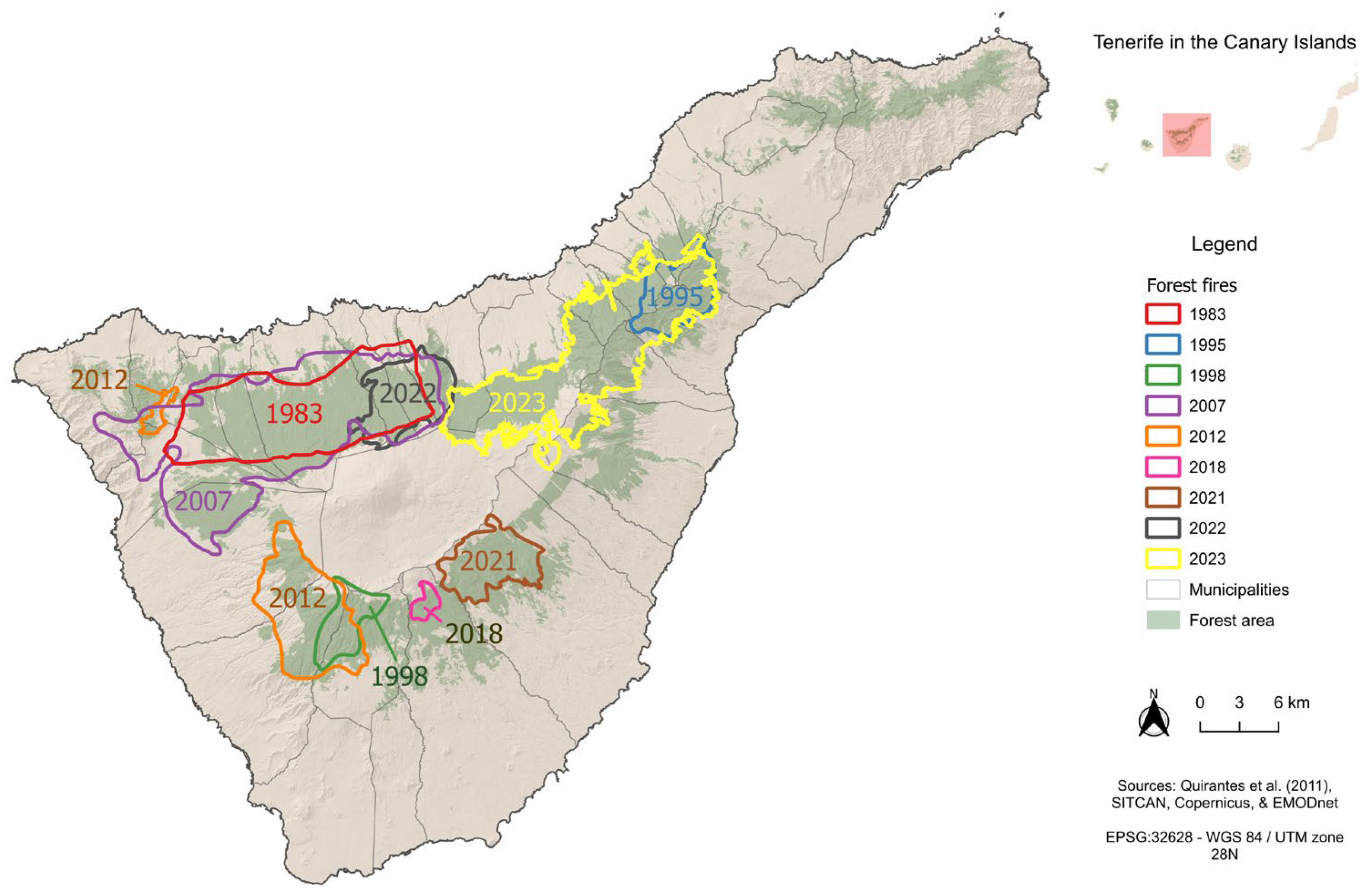

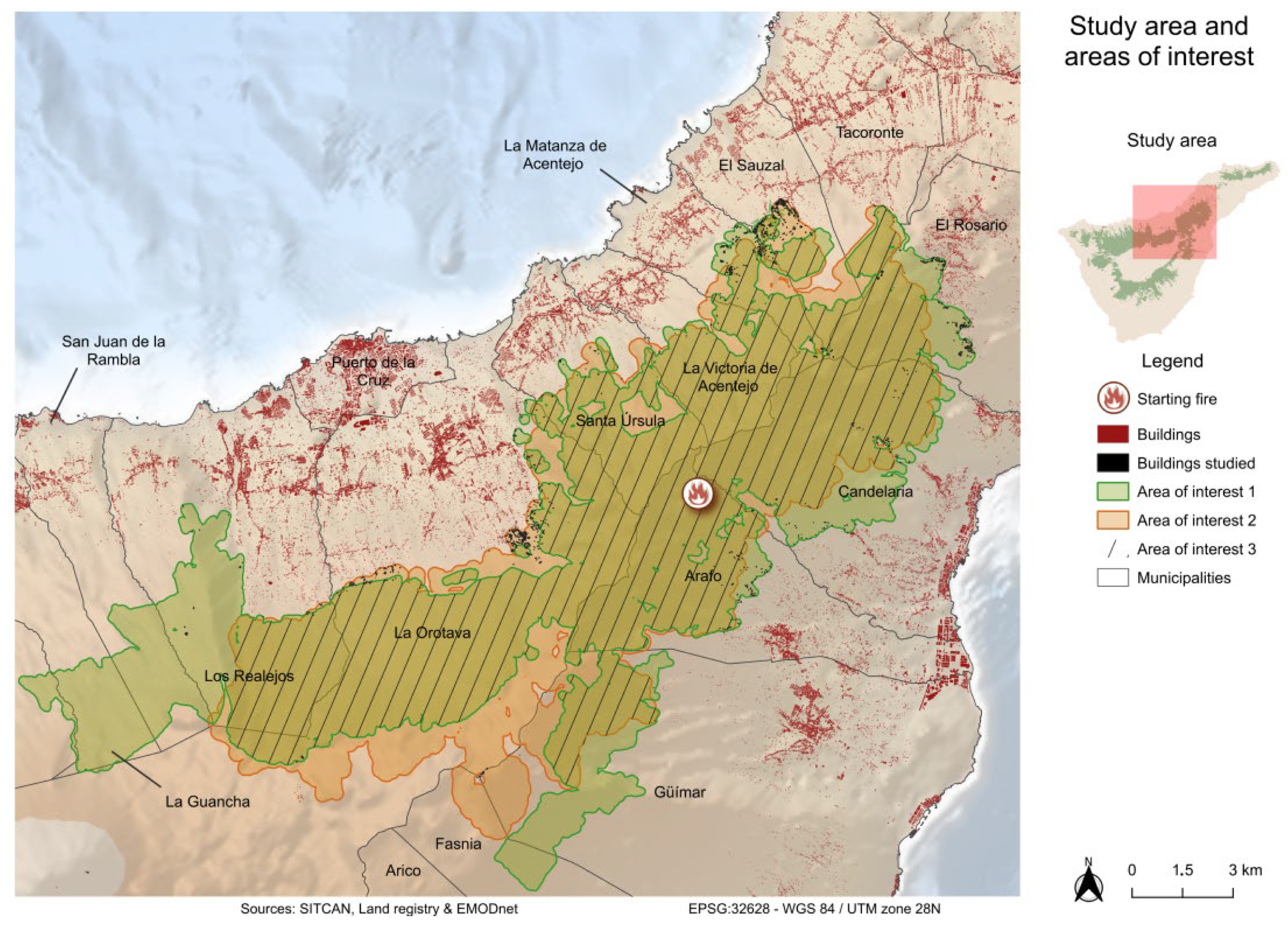
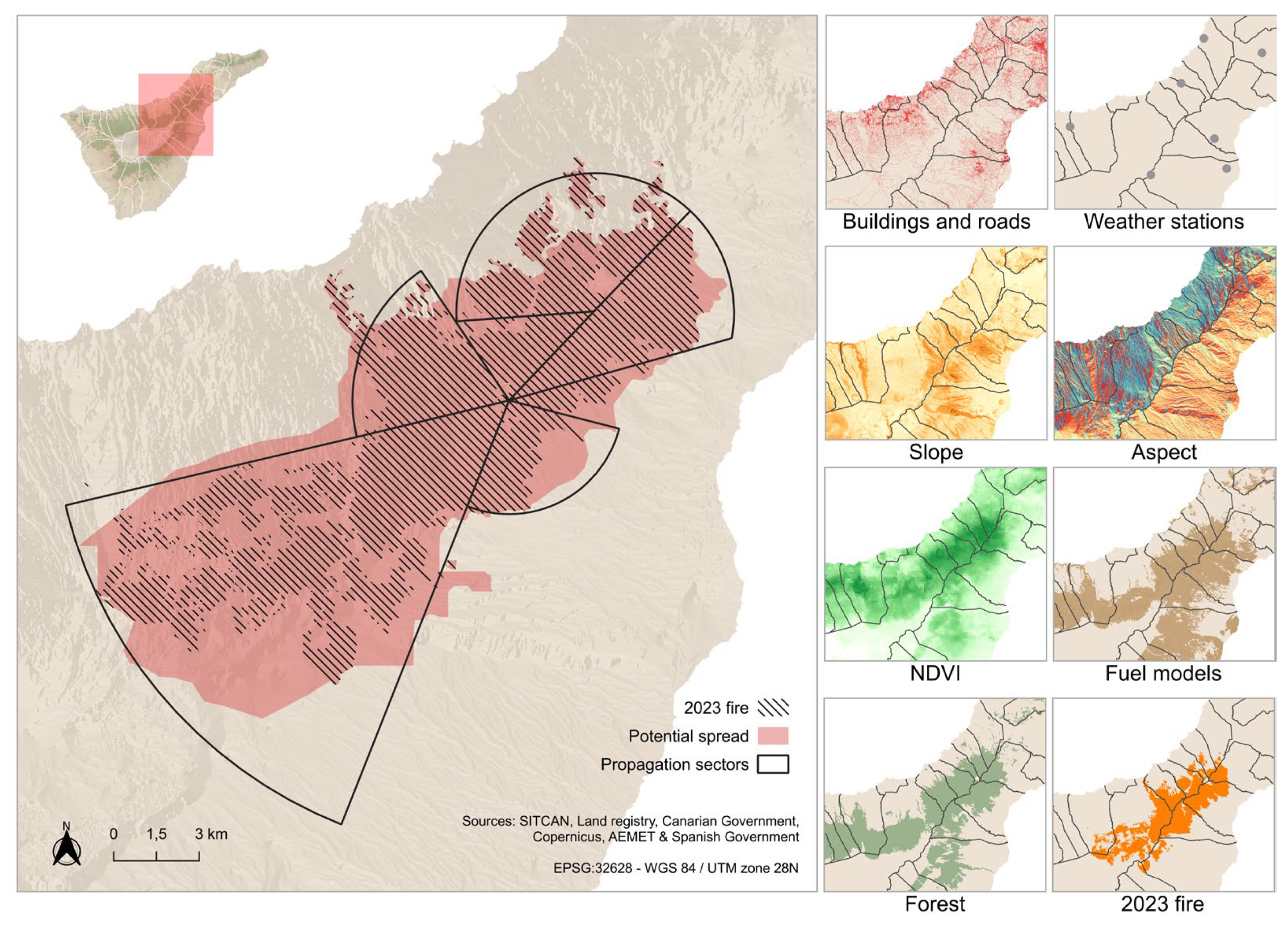
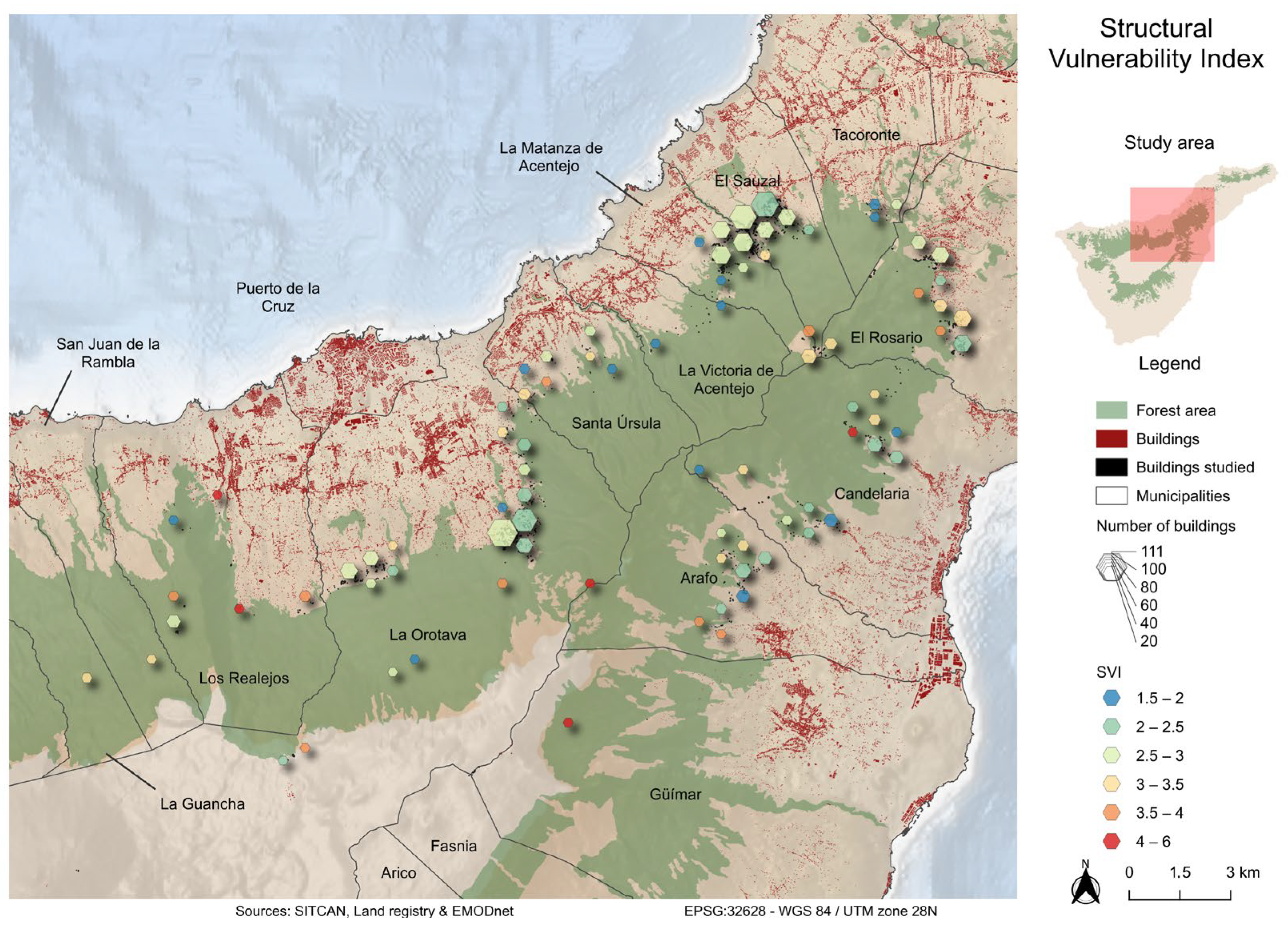
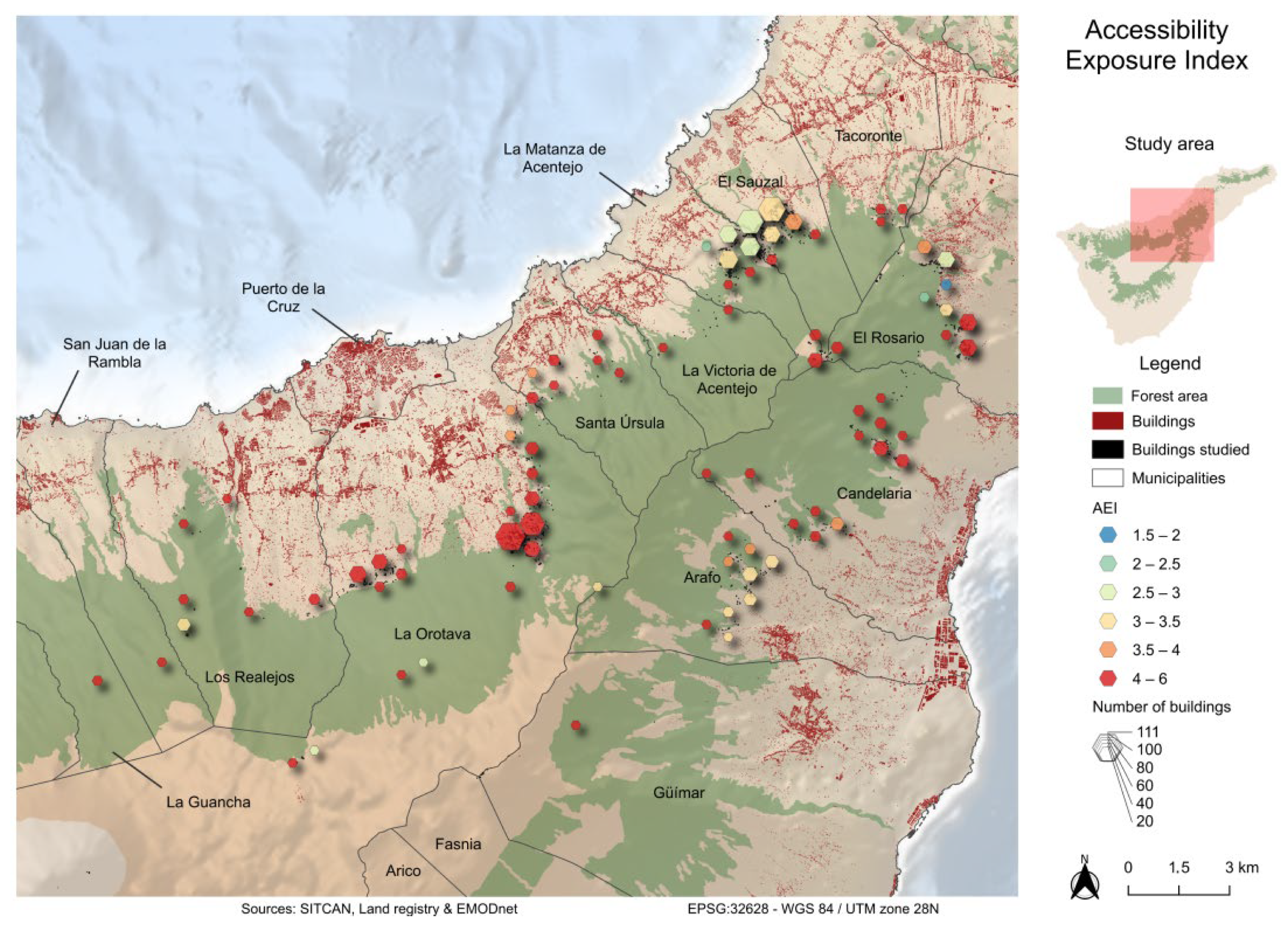


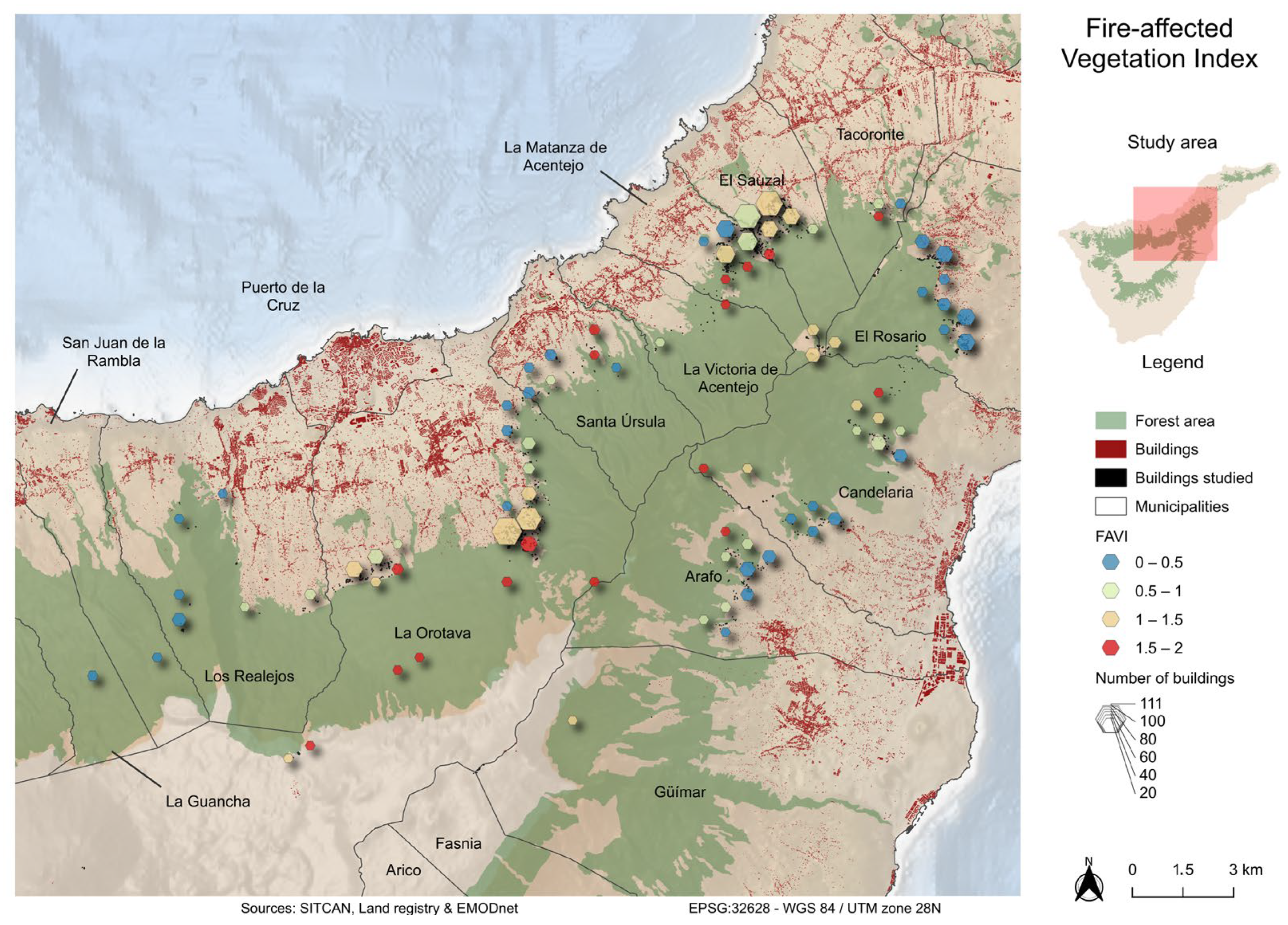
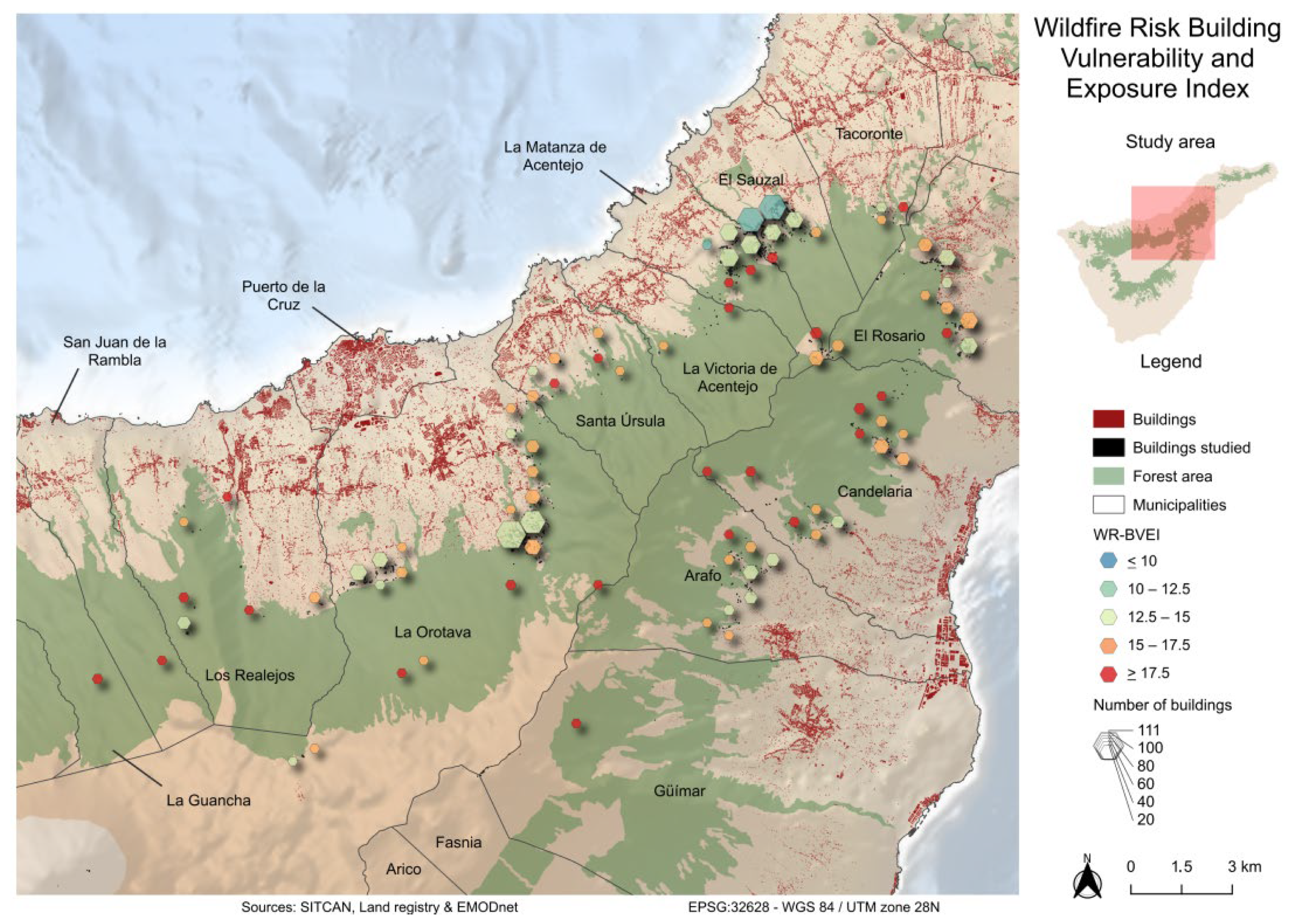
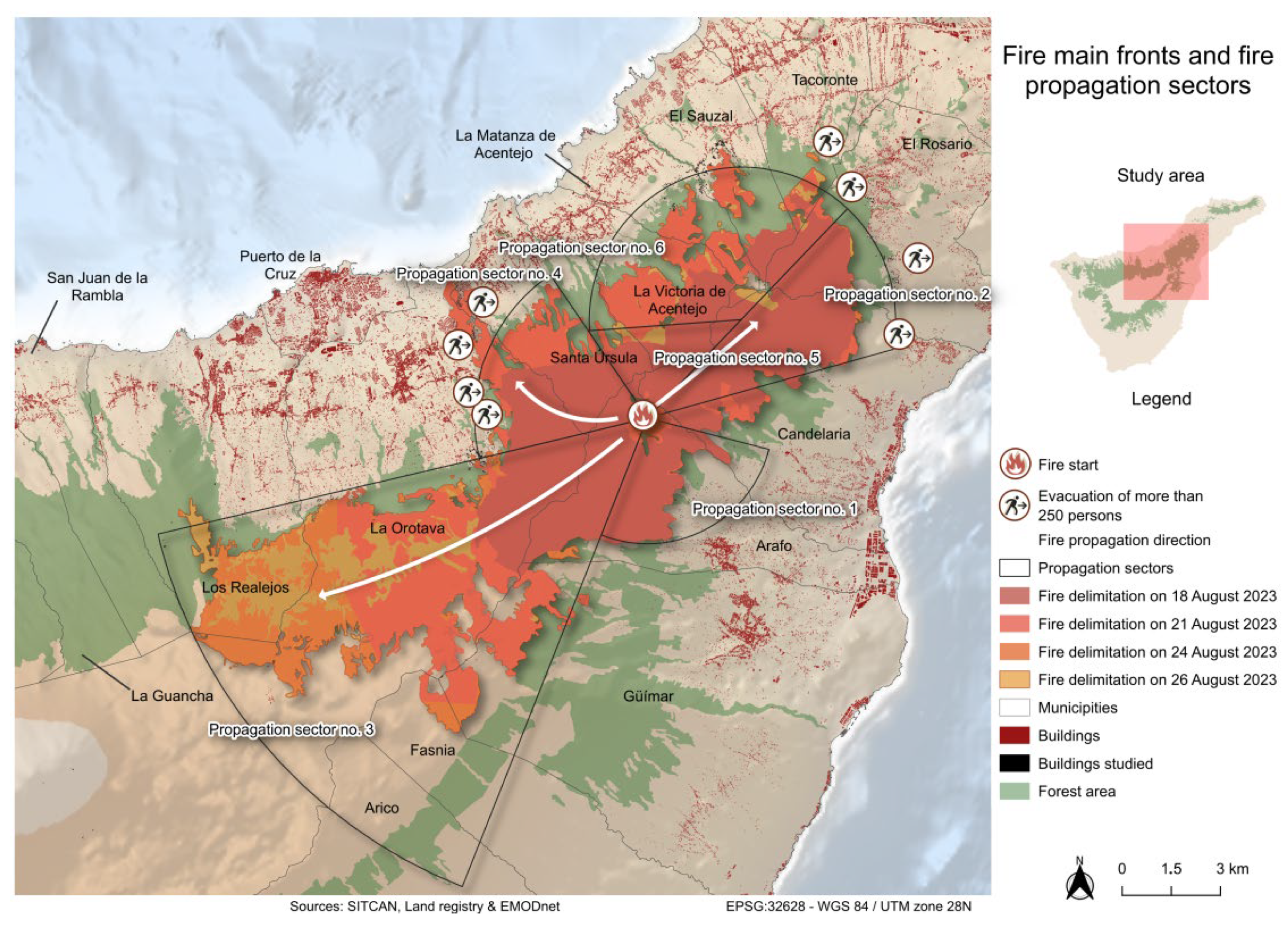
| CRITERIA | VULNERABILITY AND EXPOSURE EVALUATION | |||
|---|---|---|---|---|
| Low (0.5) | Moderate (1) | High (1.5) | Very High (2) | |
| STRUCTURAL VULNERABILITY INDEX (SVI) | ||||
| Structural material | Non-flammable (stone, brick, cement, etc.) | Low flammability (e.g., fireproof woods) | Moderately flammable (wood, rugs, etc.) | Highly flammable (cardboard, plastics, etc.) |
| Blinds or shutters | Presence of blinds or shutters | - | - | Absence of blinds or shutters |
| Age of buildings | 2000 or later | 1976–1999 | 1951–1975 | 1950 or earlier |
| ACCESSIBILITY EXPOSURE INDEX (AEI) | ||||
| Type of access road to the buildings | Bidirectional | - | One-way | Dead-end |
| Condition of the access road network to buildings | Excellent access road network | Good access road network | Acceptable access road network | Degraded access road network |
| Distance between buildings and extinguishing means | <5 min | <15 min | <30 min | >30 min |
| TERRITORIAL EXPOSURE INDEX (TEI) | ||||
| Slope of the land | Buildings located in areas (radius of 100 m) with a slope of 10° or less | Buildings located in areas (radius of 100 m) with a slope between 10° and 15° | Buildings located in areas (radius of 100 m) with a slope between 15° and 25°. | Buildings located in areas (radius of 100 m) with a slope of more than 25° |
| Proximity to ravines | Buildings located more than 200 m from a ravine | Buildings located between 100 and 200 m from a ravine | Buildings located between 50 and 100 m from a ravine | Buildings located less than 50 m from a ravine |
| Type of settlement around the urban–forest interface | Very dense population | Dense population | Dispersed population | Isolated population |
| VEGETATION EXPOSURE INDEX (VEI) | ||||
| Distance between buildings and forested areas | >50 m | 30–50 m | 10–30 m | <10 m |
| Proximity between buildings and tree canopies | >30 m | 10–30 m | 2–10 m | <2 m |
| Presence of potentially pyrophytic vegetation (fuel models with fast and easy propagation). | No pyrophytic vegetation within a radius of 100 m. | No pyrophytic vegetation within a radius of 50–100 m. | With pyrophytic vegetation in a radius of 30–50 m. | With pyrophytic vegetation within 30 m of the building |
| FIRE-AFFECTED VEGETATION INDEX (FAVI) | ||||
| Presence of vegetation affected by the fire in the vicinity of buildings. | No surrounding vegetation affected | Affected vegetation within a radius of 200 m | Affected vegetation within the property | Affected vegetation in the immediate vicinity of the building |
| WR-BVEI Value | Vulnerability and Exposure Categories |
|---|---|
| ≤10 | Very low |
| 10–12.5 | Low |
| 12.5–15 | Moderate |
| 15–17.5 | High |
| ≥17.5 | Very high |
| Element | Explanation | Value |
|---|---|---|
| Forest area | Economic production of forests (wood, beekeeping, livestock, etc.), excluding recreational and environmental activities [61] | EUR 2125/ha |
| Investment in forest fire emergency preparedness | Public investment for the prevention and extinction of forest fires, protection of wild flora and fauna, creation and maintenance of forest roads, forest research, etc. [24] | EUR 123/ha |
| CO2 capture | Cost per CO2 captured. Only the value of live standing wood is included. It is calculated as follows: 1.18 tCO2/m3 × (ha of conifers salvaged × m3 of conifers per hectare) × market price [24,62,63] | EUR 8563/ha |
| Buildings | Value of the real estate market in the third quarter of 2023, divided by two for buildings smaller than 40 m2 or of a provisional nature and by four for sheds and warehouses [64] | EUR 1679/m2 |
| Land erosion | Average cost of land lost due to forest fire [65] | EUR 5.82/ha |
| Agricultural production | Average price of agricultural land in the Canary Islands [66] | EUR 83,299/ha |
| Infrastructure and land for primary sector activities | Average price of artificial surfaces used for primary sector activities, such as agriculture, livestock, forestry, mining, or fish farming. Includes infrastructure and associated land but not agricultural or livestock plots directly [67] | EUR 2.65/ha |
| Recreational | Average cost of artificial surfaces destined to non-productive services, such as commerce, hotels, offices, and leisure, provided they are outside the urban fabric and are easily identifiable. Includes recreational parks, amusement parks, zoos, resorts, and campgrounds [67] | EUR 1152.71/ha |
| Wood production | Average cost of areas under logging and wood processing [67] | EUR 1.37/ha |
| Conservation of biological diversity | Public investment per hectare for the protection and preservation of ecosystems and species [67] | EUR 15.81/ha |
| Water supply | Average cost of infrastructure dedicated to water treatment, purification, storage, and distribution [67] | EUR 793.8/ha |
| Type | Estimated Salvaged Assets | Value | Estimated Damaged Assets | Estimated Loss Value (EUR) | Estimated Salvaged Value (EUR) |
|---|---|---|---|---|---|
| Buildings | |||||
| Housing | 407 | EUR 1679/m2 | 50,465 m2 | 1,062,744 | 25,417,707 |
| Housing <40 m2 or temporary | 268 | EUR 420/m2 | 10,665 m2 | 411,876 | 1,342,910 |
| Other (camping, warehouses, etc.) | 257 | EUR 210/m2 | 22,475 m2 | 334,593 | 1,414,998 |
| Subtotal | EUR 1,809,213 | EUR 28,175,615 | |||
| Environment | |||||
| Environmental | 9119 ha | EUR 2125/ha | 11,965 ha | 25,425,625 | 19,377,875 |
| Land erosion | 9119 ha | EUR 6/ha | 11,965 ha | 69,636 | 53,073 |
| Investment in forest fire emergency preparedness | 9119 ha | EUR 123/ha | 11,965 ha | 1,471,695 | 1,121,637 |
| Conservation of biological diversity | 9119 ha | EUR 15.8/ha | 11,965 ha | 189,167 | 144,171 |
| Water supply | 9119 ha | EUR 793.8/ha | 11,965 ha | 9,497,817 | 7,238,662 |
| Subtotal | EUR 36,653,940 | EUR 27,935,419 | |||
| Productive | |||||
| Wood production | 9119 ha | EUR 1.37/ha | 11,965 ha | 16,392 | 12,493 |
| Infrastructure and land for primary sector activities (without agricultural or livestock plots) | 9119 ha | EUR 6.65/ha | 11,965 ha | 31,707 | 24,165 |
| Crops | 511,934 ha | EUR 83,299/ha | 109,928 ha | 9,157,059 | 42,640,758 |
| Recreational | 9119 ha | EUR 1152.71/ha | 11,965 ha | 13,676,904 | 10,511,562 |
| Subtotal | EUR 22,882,062 | EUR 53,188,978 | |||
| Immaterial | |||||
| CO2 | 9119 ha | EUR 8563/ha | 11,965 ha | EUR 102,456,295 | EUR 78,085,997 |
| TOTAL | EUR 163,801,509 | EUR 187,386,008 | |||
Disclaimer/Publisher’s Note: The statements, opinions and data contained in all publications are solely those of the individual author(s) and contributor(s) and not of MDPI and/or the editor(s). MDPI and/or the editor(s) disclaim responsibility for any injury to people or property resulting from any ideas, methods, instructions or products referred to in the content. |
© 2025 by the authors. Licensee MDPI, Basel, Switzerland. This article is an open access article distributed under the terms and conditions of the Creative Commons Attribution (CC BY) license (https://creativecommons.org/licenses/by/4.0/).
Share and Cite
Correa, J.; Boulat, L.; Dorta, P. Forest Fires, Vulnerability, and Exposure: The Evaluation of What Was Salvaged in the 2023 Fire in Tenerife (Spain). Fire 2025, 8, 186. https://doi.org/10.3390/fire8050186
Correa J, Boulat L, Dorta P. Forest Fires, Vulnerability, and Exposure: The Evaluation of What Was Salvaged in the 2023 Fire in Tenerife (Spain). Fire. 2025; 8(5):186. https://doi.org/10.3390/fire8050186
Chicago/Turabian StyleCorrea, Jordan, Lucie Boulat, and Pedro Dorta. 2025. "Forest Fires, Vulnerability, and Exposure: The Evaluation of What Was Salvaged in the 2023 Fire in Tenerife (Spain)" Fire 8, no. 5: 186. https://doi.org/10.3390/fire8050186
APA StyleCorrea, J., Boulat, L., & Dorta, P. (2025). Forest Fires, Vulnerability, and Exposure: The Evaluation of What Was Salvaged in the 2023 Fire in Tenerife (Spain). Fire, 8(5), 186. https://doi.org/10.3390/fire8050186









